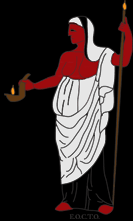
Festival of Oskhophoria
October 22
(Greek) Ancient: 7 Puanepsion (first quarter).
The Oschophoria is a vintage and wine-pressing festival, in thanks to Dionysos, held on the same day as the
Puanepsia, when the Mysteries of Dionysos were also held. Thus we find the two apparent polar opposites, Dionysos
and Apollo, honored on the same day, but we must not forget that They also shared the sanctuary at Delphi: Apollo
honored there in the summer, Dionysos in winter (when Apollo is in Hyperborea). An ancient krater (mixing bowl)
shows them shaking hands over the Omphalos at Delphi.
There is a procession from the temple of Dionysos to the temple of Athena Skira, for the grape harvest is one aspect of Her concern for the well-being of the community (cf. the Arrhephoria and Skiraphoria, both in mid-late June). This aspect of Athena may derive from the vine goddess Skiras, worshipped in Salamis, whence She came to Athens (see the Skiraphoria discussion for another idea of the meaning of skira).
The procession is headed by the two Oskhophoroi (Vine-branch Bearers), young men who carry branches still bearing grapes (oskhoi) and are dressed as women, which recalls the androgyny of Dionysos, for they wear the same Ionic khiton (ankle-length tunic) as He sometimes does. Behind them comes a chorus singing special hymns to the God.
They are accompanied by a herald, who has a garland wrapped round his staff, rather than around his head, as would be the normal custom. This was explained by the Theseus myth: when his herald told the Athenians of Theseus’ return, in their joy they tried to crown him with a wreath, but he refused it because he had learned of the tragic death of Theseus’ father. Therefore he returned to Theseus with the wreath wrapped around his staff.
The procession also includes Deipnophoroi (Dinner Carriers), women who bring thefood for the sacred feast that follows the sacrifice. A portion of the meat is burned for the God and some is eaten by the celebrants; the rest is divided to be taken home. Stories are told during the feast, especially the story of Theseus and Ariadne, and how she was claimed by Dionysos. The Deipnophoroi represent the Mothers of the Twice-Seven, who brought meat, bread and heartening stories to their children, the seven maids and seven lads chosen to sail to Crete to be sacrificed to the Minotaur (a ritual confrontation of 14 “Beauties” with the Beast).
The legend also explains the transvestite Oskhophoroi, for Theseus chose two boys with girlish features, and trained them to walk and act like girls so that they might substitute for two of the condemned girls to protect the others. In the festival they carry vine-branches and lead the procession, as they did in Theseus’ triumph, in thanks to Dionysos and Ariadne. (Of course, such transvestitism is not unusual in the rituals of Greece or other cultures.) When the procession arrives at the sanctuary, there are songs, both happy and sad, and libations are poured to the God, followed by shouts of:
Eleleu! Iou! Iou!
The yell is paradoxical in that “Eleleu!” (pronounced “e-le-LOO!”) is a cry of encouragement (from elelizo, to rally), whereas “Iou!” (pron. “yew!”) is a cry of woe (Latin Heu!). This was explained by the mixed joy and grief of Theseus’ return and his father’s death, but it also celebrates the death and resurrection of Dionysos as Vegetation God. [NFR 34–5; PFA 77–81; SFA 89–92]
